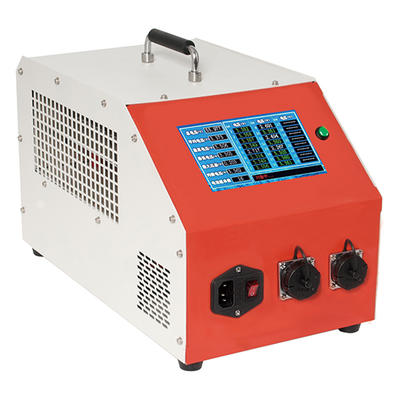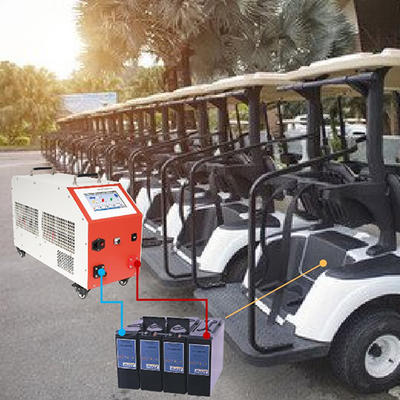The battery charge and discharge tester integrates battery constant current discharge, intelligent charging, activation, and monomer monitoring. One machine is multi-purpose, reducing the cost of enterprises, reducing the labor intensity of maintenance personnel, and providing comprehensive and scientific testing methods for battery and UPS power maintenance. Used in telecommunications, base stations, electric power and other departments. Deep discharge as needed, then recharge, keep the battery pack fully charged at any time and prolong battery life, it is a good assistant for battery maintenance work.

So how should the battery charge and discharge tester be used? The following will give you a detailed introduction.
1. Tester installation
1). Grounding wire is required to ensure equipment and personal safety.
2). Make sure that the "air switch" is in the off state to connect and disconnect the connecting wire with the battery pack.
3). The red connecting wire of the battery pack is connected to the positive pole, and the black one is connected to the negative pole.
4). After the quick plug and charging power plug are inserted into the socket, they should be tightened clockwise to prevent heat generation during high current.
5). The "1" line (black clip) of the single-cell battery detection connection line starts from the negative pole of the battery pack, (and so on).
2. Tester parameter settings
1). Charge/discharge current: take 1A as the basic unit.
2). The charging/discharging time, the number of minutes should not exceed 59 minutes.
Such as: 1 hour and 20 minutes, can not be set to 00HH80MM but 01H20M.
3). The low limit protection voltage of the battery pack: generally take 90% of the sum of the nominal voltage value of the battery. Set it correctly to prevent damage to the battery due to overdischarge.
4). Charge/discharge capacity: If the charge/discharge termination condition is not set according to the capacity, please set it to 9999Ah. (max).
5). Before discharge, voltage and current correction values are set to +00% or -00%. ?
3. Charge/discharge process
1). There must be a special person on duty when the machine is working.
2). Do not touch the stainless steel cover with your hands during the discharge process to avoid burns.
3). In case of special circumstances, the "power switch" and "air switch" should be turned off immediately.
4). After the charging/discharging is completed, when transferring data, wait until the display prompts that the transfer is over, and then unplug the U disk.
4. Emergency measures
1). When the voltage of a single battery is less than or equal to 11V or the voltage of the whole group of batteries is less than or equal to 198V, stop discharging.
2). When the battery discharge meter indicates that the voltage drops to 200V, the monitoring of battery discharge should be strengthened to ensure that the battery voltage should not be lower than 198V and overdischarge.
3). Strictly observe whether the fan of the discharge instrument rotates during the discharge process. If it does not rotate, stop the discharge immediately.
4). When the discharge detector is connected to the battery, the positive and negative shall not be reversed.
5). The equipment is placed in a well-ventilated, dew-free and non-corrosive environment, and the ventilation holes must not be blocked to ensure good ventilation!
6). The discharge instrument shall not be connected with live wires during normal operation, otherwise it will cause damage to the connection terminals and circuits.
7). Safety measures should be taken when discharging and testing the battery voltage. It is strictly forbidden to short-circuit the positive and negative electrodes.
8). During the charging and discharging process of the battery, switch operations should be minimized.
9). During the discharge process, the on-duty personnel should strengthen the monitoring of the DC high-frequency module (AC-DC input and output voltage), the DC screen control, and the voltage of the combined bus, and report and deal with it in time when any abnormality is found;

E-Nanny Electricfactory has been engaged in electrical testing solutions for many years, focusing on the full line of electrical testing equipment including withstand voltage testers, transformer testers, gis testers, relay protection testers, cable fault location systems, insulation resistance testers, etc. It is a high-tech enterprise that develops, produces, sells, and provides a complete set of testing and maintenance solutions. The products involve power battery testing and maintenance, data monitoring and storage, efficient sorting of battery module-level single cells, as well as grouping, energy storage management systems and other equipment fields. Customers are all domestic power battery manufacturers, new energy vehicle manufacturers, echelon Use recycling companies and companies such as energy storage applications.
 English
English
 Español
Español
 Português
Português
 русский
русский
 français
français
 日本語
日本語
 Deutsch
Deutsch
 Tiếng Việt
Tiếng Việt
 Italiano
Italiano
 Nederlands
Nederlands
 Pilipino
Pilipino
 Türk
Türk
 Gaeilge
Gaeilge
 عربى
عربى
 Indonesia
Indonesia
 norsk
norsk
 čeština
čeština
 Ελληνικά
Ελληνικά
 فارسی
فارسی
 தமிழ்
தமிழ்
 Српски
Српски
 Català
Català
 עִברִית
עִברִית
 Galego
Galego
 Беларус
Беларус
 Hrvatski
Hrvatski
 ជនជាតិខ្មែរ
ជនជាតិខ្មែរ
 Кыргыз тили
Кыргыз тили
 O'zbek
O'zbek
 Lëtzebuergesch
Lëtzebuergesch
 ไทย
ไทย
 Polski
Polski
 한국어
한국어
 Svenska
Svenska
 magyar
magyar
 Malay
Malay
 বাংলা
বাংলা
 Dansk
Dansk
 Suomi
Suomi
 हिन्दी
हिन्दी
 български
български
 ລາວ
ລາວ
 Latine
Latine
 Қазақ
Қазақ
 Euskal
Euskal
 Македонски
Македонски
 Lietuvos
Lietuvos
 Eesti Keel
Eesti Keel
 Română
Română
 मराठी
मराठी




